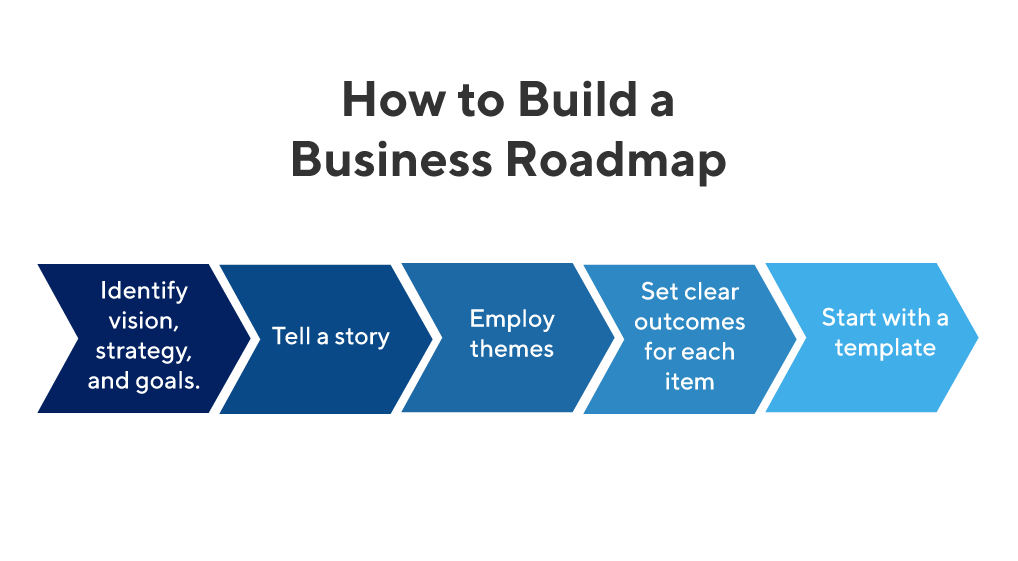Product roadmaps? Old hat. Project roadmaps? Yeah, those make sense. Business roadmaps? Never heard of them.
That’s not an uncommon starting point. Roadmaps aren’t traditionally associated with more general “business” topics. But if you circle back to the concept of what is a roadmaps in general, it makes sense.
You’ve got goals and objectives, and multiple steps to get there. How are we going to make this happen? The question is where a business roadmap can create alignment by visually explaining how everything will come together to make that vision become a reality.
What is a Business Roadmap?
Most businesses start with a business plan. The business plan is often used to secure funding from banks or investors. This plan will identify opportunities and provide a market analysis of the current players and solutions addressing these opportunities.
The plan then points out how the company can attack this opportunity in a novel way. From there, it will delve into the details of the execution. It may also touch on the management team before getting into the financials.
Business plans are dense, text-heavy documents. Aside from some charts and graphs to hammer points home, they’re not particularly visual. They’re also often pretty light on the execution phase of things.
But here is where business roadmaps can shine. They complement the business plan while bringing it to life. The business plan itself doesn’t provide much specific direction. The roadmap blows out what needs to happen when it needs to happen and who needs to do it.
With a business roadmap, it becomes crystal clear how various roles, tasks, and responsibilities come together. Best of all, it’s available at a glance and easily updated, versus having to sift through pages of text or the minutiae of project plans.
Unlike product roadmaps—where dates are discouraged—they’re an essential aspect of a business roadmap. Business roadmaps are all about the logistics. Whereas, prroduct roadmaps tend to disconnect those from the vision and goals of a product.
When well constructed with thoughtful and thorough consideration, a roadmap lays out everything required to turn a business plan into reality. Stakeholders and individual contributors alike can get the full picture.
It shows the siloed activities of different departments in the context of the larger plan. The knock-on effects of any delays or disruptions are visible.
Beyond the Business Plan
Not every business roadmap needs to encompass the entirety of a company. They can map out more discrete topics, as well.
Businesses must deal with transformational activities throughout their existence. Business roadmaps can help those processes run more smoothly and build consensus within the organization.
For example, sometimes, businesses must make a significant change. This could be a change in the business model, a shift in underlying technology or suppliers, or a new go-to-market strategy. These types of undertakings involve lots of moving pieces and multiple departments. A roadmap is an excellent tool for indicating who’s on the hook for what and when.
Businesses can also benefit from a roadmap when they’re looking to add new capabilities. It could be creating a new business unit, debuting a new offering, or adding support for new platforms and partners. Once again, many teams involved, lots of dependencies, it’s a great candidate for a business roadmap.
Architectural and IT initiatives are also perfect for roadmaps, as are other strategic endeavors such as research projects, new sales initiatives, and compliance projects.
Key Ingredients in a Business Roadmap
Business roadmaps are only useful if they’re intelligible to the audience. To ease consumption, make sure they include these aspects as a baseline.
Breakdown by organizational department:
Showing what each part of the company is working on is helpful for a few reasons. First and foremost, the visual presentation of what’s on each group’s plate might surface resourcing issues. That could result in reshuffling some priorities or reassigning tasks.
It also helps the other groups in the company understand what their colleagues are working on. No more “we’re slaving away while they’re eating bon-bons” theories when it’s all laid out for everyone to see. Plus, the additional visibility builds in more accountability. Everyone knows what they’re expected to deliver and why.
State the purpose of each activity:
Spelling out what everyone’s working on is great. Still, it’s more useful when there’s an understanding of why that task is being performed at all. By putting each activity into a category identifying its purpose, business roadmap consumers get some extra context.
Tying each activity back to a strategic goal is a great way to do this. And if each activity is color-coded by a strategic goal, it’s a quick indication of the equal weight of effort or resources on one or two during particular periods of time.
Milestones:
We typically think of milestones on a roadmap as software releases or new versions of the product. But on a business roadmap, a milestone can represent any accomplishment or key event.
It could be hitting a revenue target, a trade show or industry event, a strategic partnership, an important meeting, launching in a new region. Anything that’s a noteworthy result of the combined efforts of the teams involved. Milestones add even more context, and potentially a bit of urgency, to the roadmap.
Tips for Creating a Compelling Business Roadmap
While business roadmaps are a different beast than product roadmaps, some basic principles still apply.

Step 1: Vision, strategy, and goals
Business roadmaps are execution-focused and will likely include more specificity than an ideal product roadmap. But they’re still intended to paint a picture. There’s a vision of where you want to be, a strategy on how to get there, and goals along the way.
While the vision, in this case, is probably not a finished product, employing similar conventions regarding what makes a great roadmap is still valid. All the tasks included in a business roadmap should represent the incremental steps required to turn that vision into reality according to the strategy laid out in the business plan.
Step 2: Tell a story
We’ve mentioned many times how important it is for roadmaps to be narrative and for their creators to be storytellers. This belief holds true for business roadmaps, as well.
There’s a problem to solve and a state of being for the business to achieve. There are chronological steps that various parts of the organization must take to get there. The business roadmap can paint that picture. It can show how each bit of progress builds on the next to complete the story.
Step 3: Employ themes
Another hallmark of a great roadmap is using themes to group things together. While a business roadmap may require more concurrent activity than a typical product roadmap, themes still have a role to play.
For a business roadmap, themes might be more along the lines of “setting the stage for transformation,” “updating critical systems,” “going to market,” or “engaging channel partners.” Themes further solidify the context of each task and bundling them accordingly.
Step 4: Clear outcomes for each item
If something is important enough to make your business roadmap, at completion, there should be a positive, measurable outcome. What can we do now that we couldn’t do before? And, in case it’s not obvious, why is that so important?

Uncharted Territory
Now you know what is a business roadmap. Business roadmaps might be new to your organization (or to you). Still, they’re a powerful tool for consolidating a lot of information into an easy-to-digest, highly visible format. If you’re ready to explore how simple it can be to align your organization with a business roadmap, check out this template and see for yourself!




